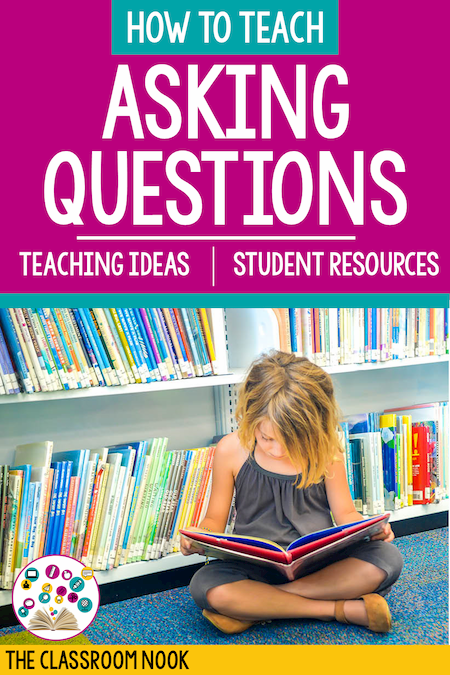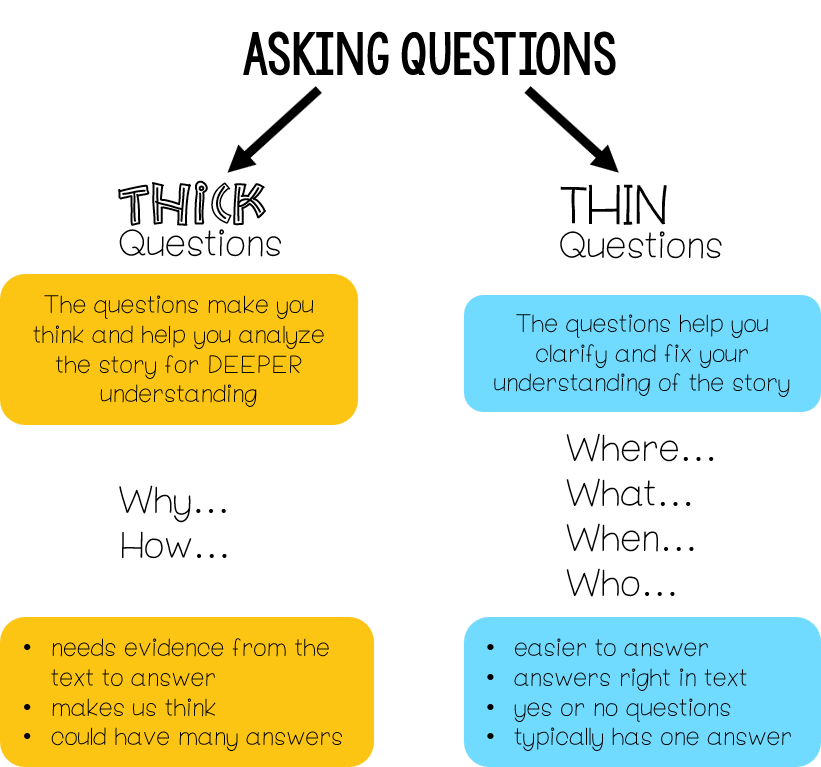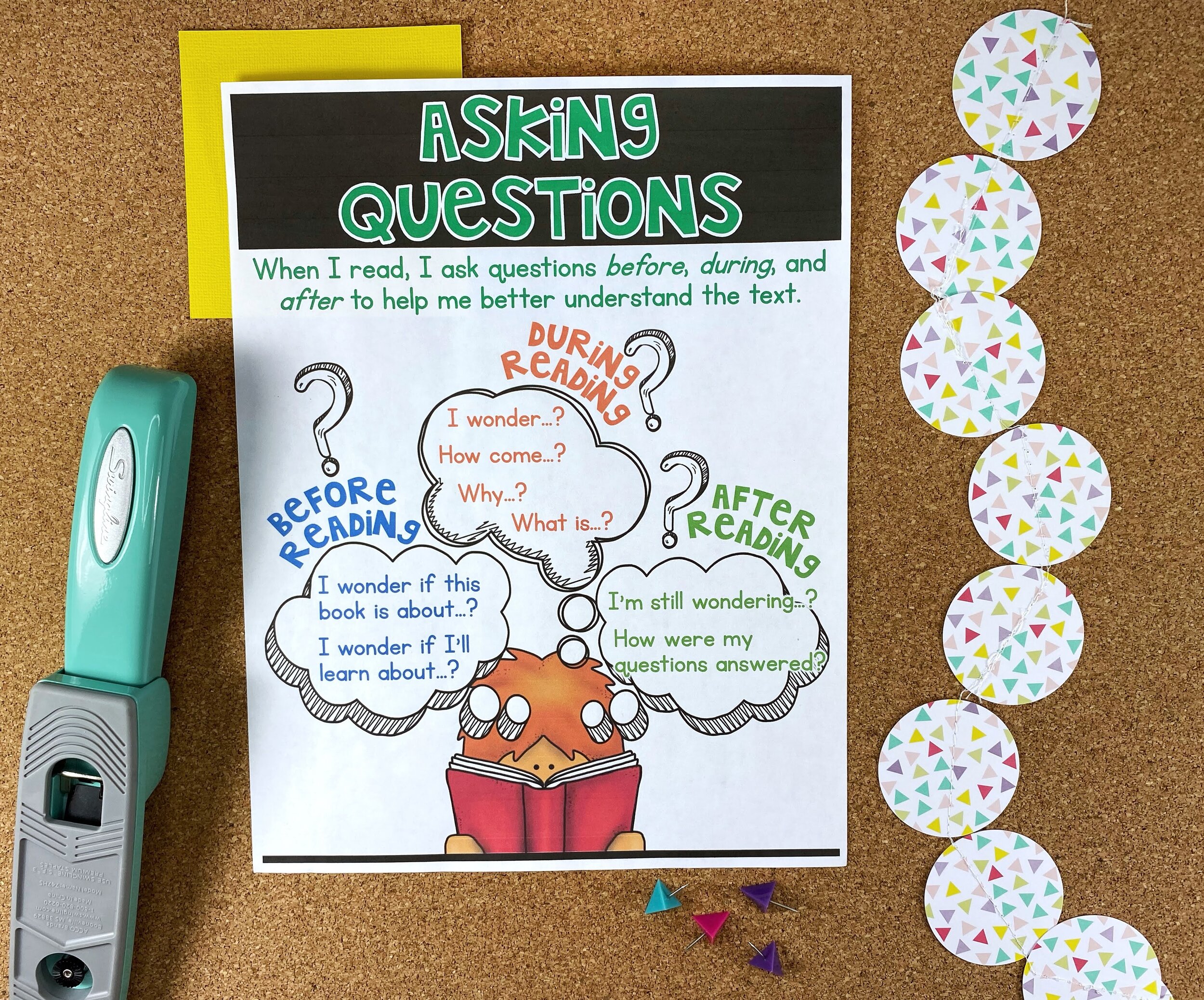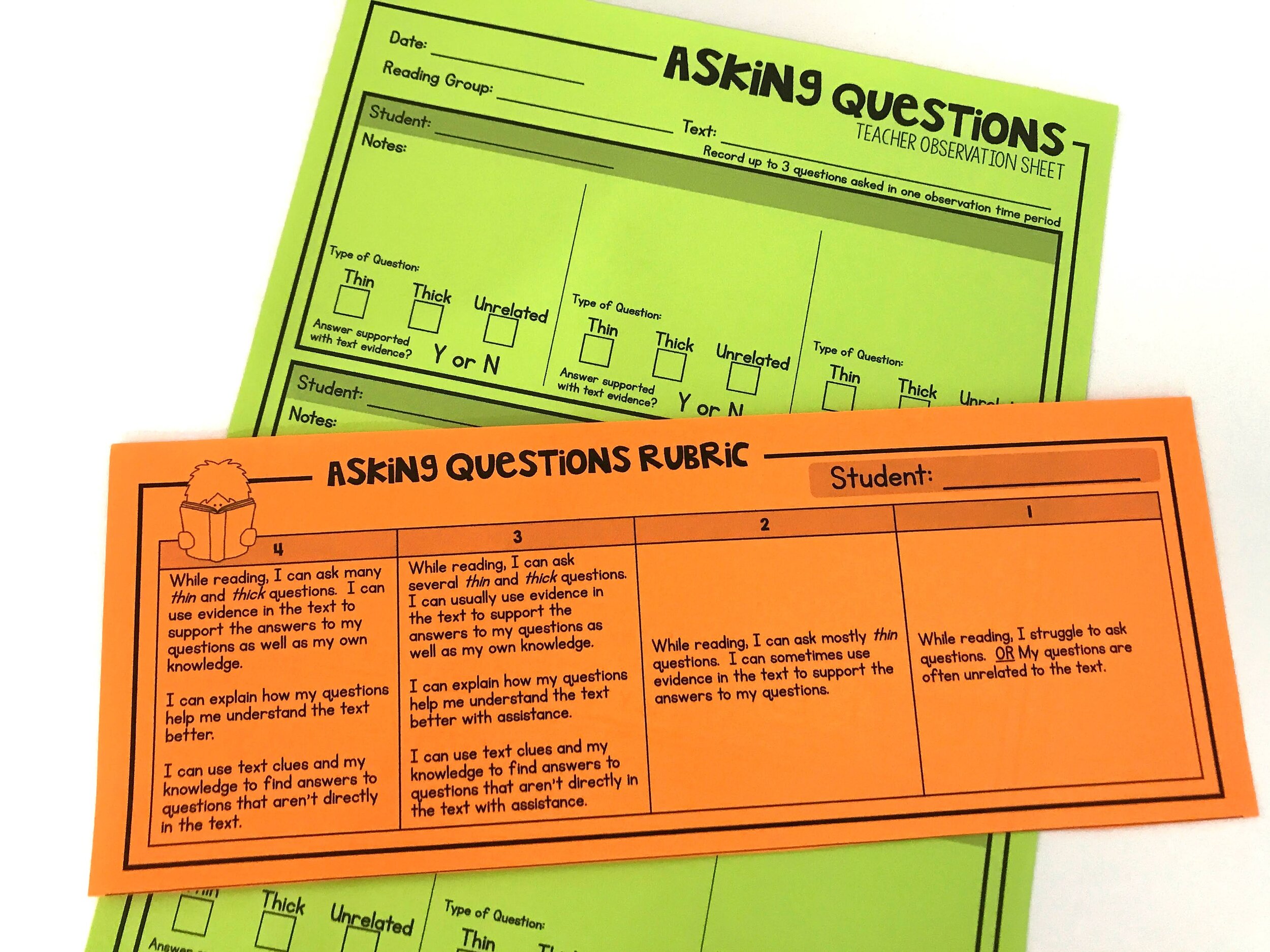How to Ask Good Read Aloud Questions
Reading Comprehension Strategy Series: How To Teach Students to Enquire Questions When They Read

Questioning is a reading strategy that is taught to students to assist them engage with the text. It helps the reader to clarify what he or she is reading and to better understand the text. Asking good questions is a way for students to monitor their own comprehension while reading.
Struggling readers approach reading as a passive feel. This ways that they read the words with the idea that the meaning of the text volition reveal itself if they read plenty words. All the same, expert readers claiming the text by asking questions as they read. They might inquire questions like: Why did they say that? What practice they hateful by that? I wonder what they were doing there? How did she do that? Why am I reading this? When taught how to enquire questions, students larn that they can increase their comprehension.
Pssst…Want a super engaging and interactive way to have students practice asking questions?
LINKtivity® Interactive Guides are EXACTLY what you need to make learning fun & attainable for all!
Go admission to the Asking Questions LINKtivity® (+threescore others and counting!) inside of LINKtivity® Learning - an all-access pass to our entire vault of LINKtivities!
Below are the different categories inside this postal service to help you jump to exactly what you need! Click on each category title to navigate in that location straight:
<< Back to categories
what yous demand to know before teaching The Questioning Reading Strategy:
Asking questions will provide students with a purpose for reading. As they read, students will seek answers to their questions for deeper meaning of the text. Students can ask questions for a variety of reasons:
-
to clarify meaning (ex. What does that word mean? Why is that happening? What I am learning?)
-
to understand the characters and events better (ex. Why did the grapheme practice that? Why did that happen? What would happen if…?)
-
to empathise the author's intent (ex. Why did the author write this?)
-
to brand predictions (ex. I wonder if ____ volition happen?)
Good readers actively ask questions before, during, and afterwards reading. Before reading, students might ask themselves what the story will exist about, what they might learn, or what they already know nearly the topic. During reading, students pay attention to clues in the text that spark questions. Since each student has dissimilar background noesis, each reader will wonder different things about the text.
While reading, the reader's questions are constantly evolving. As questions are answered, new questions will arise. Monitoring how these questions evolve will increment comprehension.
It is also important for students to terminate and ask questions when something they read does not make sense. They may demand to analyze a meaning of a discussion, or seek to sympathise a confusing office of the story. These clarifying questions assistance students to self-monitor their comprehension.
We must likewise help students to ask relevant and logical questions. The purpose of asking questions is to enhance comprehension, therefore, any question that a educatee asks should stalk from the main ideas of the text and not but loosely related to the topic.
After reading, students evaluate their questions. They ask themselves how their questions were answered and what they have learned from the text. They also may realize that not all of their questions were answered. In these cases, students may exist required to infer their own answers based on the text and their background knowledge.
Readers ask different types of questions depending on the genre that they are reading. When reading fiction, students tend to ask questions about the characters and events. While reading nonfiction, students may ask themselves questions about what they are learning, the meaning of new vocabulary words, or what the author is trying to teach them.
Finally, when instruction the questioning strategy, it is of import for students to ask different types of questions that will improve their comprehension. This tin be referred to every bit asking "thin" vs "thick" questions. Thin questions are surface-level questions that commonly tin can exist answered by looking correct in the text. Thick questions, on the other manus, require students to use their ain groundwork knowledge to dive deeper. Answers to thick questions tin can be subject to interpretation. They utilize evidence from the text, simply too draw from the personal experience of the reader. Asking both types of questions will requite the reader a well-rounded reading experience.
<< Back to categories
INTRODUCING THE QUESTIONING STRATEGY TO STUDENTS
Equally with teaching most things, it is helpful to start with the concrete and move toward the abstract.
A great first activeness to use when introducing the questioning strategy is called "What's In My Pocketbook?"
To use this activeness, you volition first need to place an ordinary object into a paper purse. This item could exist a comb, toothbrush, a pencil, etc. It needs to exist something that students would be able to judge.
Show students your bag, but not the item in the pocketbook. Invite students to ask questions about the particular in your bag. Encourage students to ask open-ended questions to gather clues (ex. What is the item used for? Where practise you use it? Rather than: Is information technology an apple?) Students volition realize that they will get a better agreement of what the object is if they inquire these open-ended questions instead of just randomly trying to ask what the object is.
Connect this activity to real reading. When we ask adept questions, our thinking about something is refined and changes. Finding answers to our questions oftentimes leads to even more than questions, which leads to deeper understanding. For instance, in the "What In My Bag?" activeness, a student would modify their next question based on their previous question. In reading, an reply to one of our questions can dictate what our next thought or question might be. Asking questions helps students appoint with the text.
<< Back to categories
Modeling How to Inquire Questions While Reading
When you move into using this strategy with a volume, provide students with prompts that might guide their questions:
-
I wonder…?
-
How come…?
-
Why…?
-
What is…?
Yous volition first want to model using the questioning strategy in a read-aloud. Be sure to choose a book that lends itself to request questions. Begin by modeling the questions that you have before you read. You may choose to jot these questions down on an anchor chart for students to encounter. Here's a sample ballast chart:

These "earlier" questions may stalk from the title, what you already know well-nigh the topic or author, or even illustrations plant on the cover or in the book itself.
As well, model questions that you lot have during reading (jot them downwards on the anchor nautical chart). You could also write these questions down on postal service-it notes and place on the text itself where the question occurred. This volition assistance when you go dorsum to review your questions with the students later on reading.
When asking questions, betoken out in the text what sparked the question, and explain your thinking. Here's an case:
"When I read __________, it made me wonder why _______ considering ____________."
Explain to students that sometimes while reading, your questions volition be answered afterwards on in the volume, while others you lot'll take to infer the answer based on your own knowledge and the details the author does tell yous.

Later on reading, review the questions that you had previously asked. These questions tin can also exist listed on the anchor nautical chart. Discuss any answers that you may have institute to your questions, equally well as inferences y'all have for unanswered questions. Be sure to too address any lingering questions that you might have afterwards finishing the story.
Once students have had the chance to practice asking questions, help students to go deeper past asking thoughtful and complex questions. This tin be done by instruction them the difference between "Thick" and "Thin" questions. The anchor chart on the correct may exist helpful to teach the distinction between the two.
When modeling the questioning strategy, exist sure to indicate whether the question you are asking is thick or thin. Exist sure to provide multiple examples of each. If desired, go back to your original anchor chart and accept students help you identify which questions were thin and which were thick.
<< Dorsum to categories
Cull TEXTS THAT ASSIST IN ASKING QUESTIONS:
Of class nosotros want students to be able to enquire questions regardless of what book they are reading. However, as students have their first experiences working this this strategy, choose books that lend themselves to asking questions will assist students to have a quick win, and easily see this strategy in action.
Books with more than obvious opportunities to ask questions will help fix students up for success and volition train their brains to finish and inquire questions while they read AND await for those answers as the go on reading.
Hither are some of my favorites: (affiliate links)
-
The Stranger past: Chris Van Allsburg
-
The Empty Pot by: Demi
-
Wing Away Domicile by: Eve Bunting
-
Institute Secrets by: Emily Goodman
<< Dorsum to categories
Practicing Request Questions:
CREATE SIMPLE VISUALS TO REMIND STUDENTS TO Inquire QUESTIONS


Asking questions may seem second nature to u.s.a., simply young readers benefit from unproblematic reminders to utilize this reading strategy until it becomes second nature for them also. Visuals such as bookmark to utilise while reading, or a classroom affiche that is displayed on a reading strategy bulletin board work wonderfully to nudge students to ask questions while reading.
Go along to create anchor charts displaying the questions that you lot ask during read-alouds. You lot can even create a class ballast chart where students mail service their own questions about a book that you are reading together as a class.

8 FREE Reading Strategy Bookmarks
Grab these FREE student bookmarks to help your students apply reading comprehension strategies while reading.
There are a total of 8 bookmarks that explicate reading strategy in kid-friendly language and is the perfect reference for students to use during independent or small-group reading time.
USE LINKtivity DIGITAL LEARNING GUIDES
New to LINKtivities? >> CLICK Here
If you've not still discovered LINKtivity digital learning guides, then y'all (AND your students) don't know what yous're missing! LINKtivities are interactive, engaging, and then fun for learning and practicing new skills like reading strategies.
I created a LINKtivity specifically for teaching students how to inquire questions while reading. Check out the video beneath for a sneak-peek!
Here's how it works:
In the Asking Questions LINKtivity, students showtime watch a short animated video clip that chop-chop catches their attending with fun doodles and images. The clip introduces what the strategy is and how readers utilise it.
From there they read aslope their "virtual reading buddy" to come across the strategy applied to a text. While clicking through the digital book, each time the pupil comes across a thought bubble, they click on it and are brought to a new slide in the LINKtivity guide to see what their reading buddy is thinking!
So, to take their learning to the next level, students read 3 additional high-interest reading passages to practice the strategy on their own. In a similar style as they did with their reading buddy, students click through the digital storybook and stop to ask questions forth the way.
HAVE STUDENTS Keep TRACK OF THEIR QUESTIONS WHILE READING

Having students write downward their questions is critical in informing y'all of their understanding of the strategy. From their written questions you can encounter if their questions are meaningful, relevant, and logical to the story that they are reading. You tin also run across if they tend to inquire the same types of questions (thin vs. thick) and if they are seeking out answers to their questions equally they read.
Writing down their questions besides keeps them answerable for their learning and gives you an informal assessment.
<< Dorsum to categories
assessing your students on asking questions

Assessment, whether information technology be formal or informal, drives instruction. For more informal assessments, accept notes about a students use of the questioning strategy during reading conferences or in small groups. Because the post-obit when observing the students' apply of the strategy:
-
Note the types of questions a student asks (thick vs. sparse, clarifying questions, etc.)
-
Are the questions relevant to the story?
-
Do the question brand sense to the events and details of the book?
-
Can the student explicate why he/she is asking a specific question?
-
Can the student explain how the question helps his/her comprehension
-
Does the student notice when his/her questions are answered?
-
Tin can the student infer an answer to a question that has not been straight answered in the text?
-
Does the student inquire follow up questions?
Having a rubric written in kid-friendly linguistic communication is especially helpful when providing feedback to a student on their ability to ask questions. The rubric can provide clear guidelines on how to ask questions while reading.
<< Back to categories
Resources for Asking Questions

Desire to get your easily on the Asking Questions LINKtivity®?
Join the LINKtivity® Learning Membership and start using this ready-to-get resource for request questions that includes:
-
a teacher guide
-
a student LINKtivity
-
a student recording canvass
-
a student-friendly rubric
Get access to the Asking Questions LINKtivity® PLUS all the other reading comprehension strategies inside of LINKtivity® Learning - an ALL-ACCESS pass to every single LINKtivity® created (INCLUDING all 7 reading strategy LINKtivities!)
Check out the other posts in this serial
Click on whatever paradigm below to read and learn virtually another reading comprehension strategy.
Source: https://www.classroomnook.com/blog/reading-strategy-asking-questions
0 Response to "How to Ask Good Read Aloud Questions"
Post a Comment